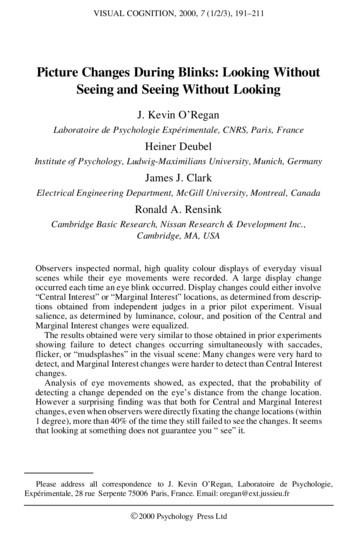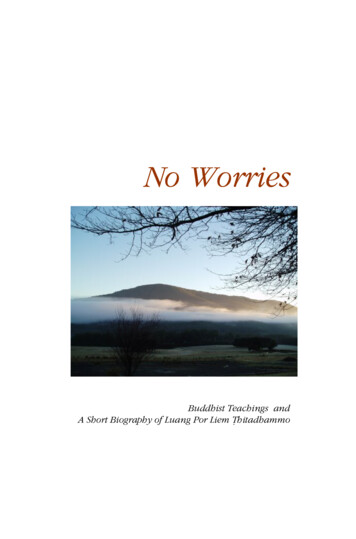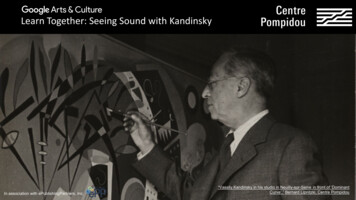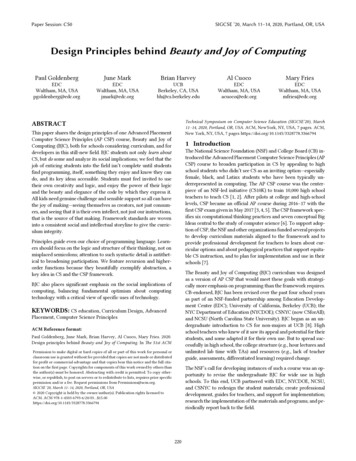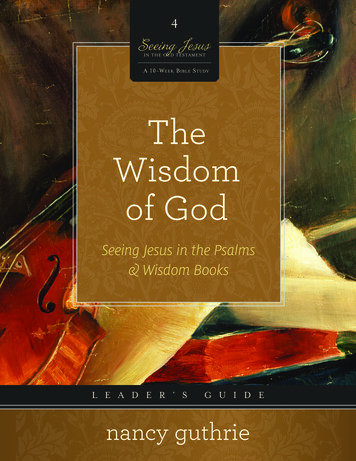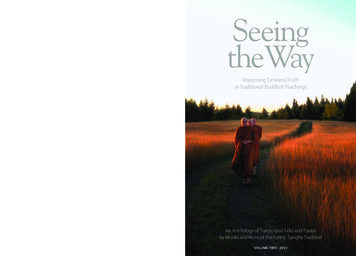
Transcription
Seeing theWay Vol. 2The first volume of ‘Seeing the Way’ was printed in 1989.Our teacher, the Venerable Ajahn Chah, had been seriously ill for anumber of years. Publishing that collection of Dhamma talks inEnglish at that time was one way of expressing our loveand gratitude to him.SeeingtheWayDiscerning Timeless Truthin Traditional Buddhist TeachingsThis new collection of transcribed talks and essays byeighteen monks and nuns, aims to present a snapshot of thecommunity of western disciples of Ajahn Chah as it is now, in 2011.Included among the contributors are many of those whose talkswere in ‘Seeing the Way’ Volume One. Also included are seniorSangha members who are currently serving as leadersof this family of monasteries.from the PrefaceDisciples of Ajahn ChahARUNA PUBLICATIONSThis book has been sponsored for free distribution.An Anthology of Transcribed Talks and Essaysby Monks and Nuns of the Forest Sangha TraditionVolume TWO - 2011
SeeingtheWayDiscerning Timeless Truthin Traditional Buddhist TeachingsARUNA PUBLICATIONS
Published by:Aruna Publications,Aruna Ratanagiri Buddhist Monastery,2 Harnham Hall Cottages,Belsay,Northumberland NE20 0HF UKwww.aruno.org ARUNA PUBLICATIONS 2011ISBN 978-0-9568113-2-5The bodytext is typeset in Gentium, developed by SIL International,and distributed with the SIL Open Font Licence.http://scripts.sil.org/GentiumThis book may be copied or reprinted in its entirety for free distributionwithout further permission. Otherwise all rights reserved.For other formats of this book see Publications in www.forestsangha.orgThis book is intended for free distribution. It should not be sold.It has been made available through the faith, effort and generosity ofpeople who wish to share the understanding it contains with whomeveris interested. This act of freely offering is itself part of what makes this a‘Dhamma publication,’ a book based on spiritual values.Please do not sell this book.If you no longer need it, please pass it on freely to another person.If you wish to help such publications to continue to be made available, youcan make a contribution, however small or large, by either contacting oneof our monasteries or by visiting www.forestsangha.orgCover photo: Near Pacific Hermitage, Washington State, USA.
DedicationWe would like to acknowledge the support ofmany people in the preparation of this book,and especially to the Kataññuta groupof Malaysia, Singapore and Australia,and the Sukhi Hotu Sdn Bhd group,for bringing it into production.shpj@sukhihotu.com
Chaptersin Europe1 : Ajahn Sumedho – The Dhamma is Right Here12 : Ajahn Khemadhammo – Invincibility113 : Ajahn Sucitto – What You Take Home with You214 : Ajahn Munindo – Radiant Non-Belief315 : Ajahn Amaro – Forgiveness416 : Ajahn Vajiro – Asubha Practice517 : Ajahn Chandapālo – Radical Purification598 : Ajahn Khemasiri – Right Orientation699 : Ajahn Sundara – Benevolence8110 : Ajahn Candasiri – The Way of Being Contented93in Thailand11 : Ajahn Gavesako – According to Kamma10512 : Ajahn Ñāṇadhammo – Walking Meditation11913 : Ajahn Jayasaro – The Real Practice13113 : Ajahn Kevali – Chanting141v
in North America14 : Ajahn Pasanno – Spiritual Friendship15315 : Ajahn Viradhammo – Acceptance & Responsibility163in New Zealand16 : Ajahn Tiradhammo – Context of Meditation17717 : Ajahn Chandako – Lotus on the Highway189vi
PrefaceThe first volume of ‘Seeing the Way’ was printed in 1989. Our teacher,the Venerable Ajahn Chah, had been seriously ill for a number ofyears. Publishing this collection of Dhamma talks in English was oneway of expressing our love and gratitude to him.Numerous requests to reprint that original anthology have beenmade over the years. The two decades that have passed since thattime, however, have found the shape and size of our communitychange considerably. Hence, rather than reprinting, I decided tooffer a ‘Seeing the Way’, Volume Two.During Ajahn Chah’s visit to Europe in 1978 he asked his seniorWestern disciple, Ajahn Sumedho, to accept an invitation toestablish a Theravada Buddhist monastery in Britain. No one knewhow things would unfold but Ajahn Chah’s recommendation was tosimply live the bhikkhu life and wait to see what happened.Now, as we begin the year 2011, Ajahn Sumedho has returned tolive in Thailand, and we reflect on what happened during thoseintervening thirty-four years. Not only was a Theravada trainingmonastery well established in the UK – Cittaviveka in West Sussex –but Ajahn Sumedho further initiated and supported the building ofseven other monasteries around the Western world: another threein Britain, and one each in Italy, Switzerland, the United States andNew Zealand. So this book also honours the dedicated commitmentof Ajahn Sumedho to the renunciate life and the many precious giftshe has given us.vii
This new collection of transcribed talks and essays by eighteenmonks and nuns aims to present a snapshot of the community ofWestern disciples of Ajahn Chah as it is now, in 2011. Included amongthe contributors are many of those whose talks were in Volume Oneof ‘Seeing the Way’. Also included are senior monks and nuns who arecurrently serving as leaders of this family of monasteries. The layoutof the chapters is determined by geographical location, a structurethat I hope will give a picture of the world-wide community. Butreaders should feel free to read the chapters in whatever sequencethey wish.However they are read, I expect that you will recognize Dhammathreads connecting all of them. One of the most evident threadsis that of relinquishment. Perhaps in the context of the modernconsumer culture –̵ it’s Western and Eastern variations –̵ there isa risk of Buddhism becoming another expression of self-seeking:doing ‘my’ practice, developing ‘my’ attainments, gaining ‘my’insights.Ajahn Chah leaves us no room for doubt. In the questionand-answer session that forms the introduction to this bookhe makes it very clear: there is nothing at all we can cling to;everything must eventually be relinquished, including ourmost precious ideas about practice. I chose to reprint this piececalled, ‘What is Contemplation’ from the first ‘Seeing the Way’,so readers might glean a sense of the way in which Dhamma istaught in this tradition. From studying suttas we recognize theimportance of solitude. Yet somewhat paradoxically it is Sangha,or spiritual community, that shows us how to truly benefit fromsolitary practice. In the company of the teacher we intuit a rightrelationship to the inner life, with its joys and sorrows, successesand failures. Ajahn Chah was ruthless in his encouragement to usto surrender ourselves into practice, holding nothing back. He didit, however, with a warmth, and often a smile, that made all theviii
difference. In the following pages I trust you will sense somethingof this generosity of spirit which naturally shines forth from thosewho, with commitment, have developed this way.In the first discourse Ajahn Sumedho inspires us towards awakeningin his talk ‘The Dhamma is Right Here’ by focusing directly onthe power of a purified awareness. He speaks of the escape hatchthrough which we can enter a new level of understanding, free fromthe undermining habits of clinging. Later on Ajahn Sucitto discussesthe wisdom that knows how to release out of our life-story, withits tragedies, heroes and villains. He emphasizes that such lettinggo is not an unwillingness to respond. However, that steadinessand completeness can be found in a quality of awareness of whatis, when we cease clinging to opinions about how things should be.Ajahn Khemasiri in his talk ‘Right Orientation’ reflects on the firsttwo factors of the Eightfold Path. He points out that renunciationpractice is for everyone; not just for those ‘gone forth.’ And that theessence of renunciation is found in what we do on the heart level,not just on the outer aspects or forms of practice.Ajahn Pasanno in his contribution considers spiritual friendship andcomments on how bringing mindfulness into all areas of life – formalpractice and daily life practice – equips us with the skill to makewise choices. He discusses how cultivating mindful relationshipleads to a tangible increased ability in taking responsibility. AjahnViradhammo directs our contemplation towards the value ofcommunity and the way practice of precepts supports letting go atthe same time as we maintain empathy. We will all face obstacles aswe travel along this path to freedom but wise companionship canprotect us from becoming too distracted or lost.Ajahn Tiradhammo highlights some of the causes for becominglost and shows us how to recognize warning signs. And both AjahnSundara and Ajahn Candasiri speak about equipping ourselves wellfor the journey ahead with conscious appreciation of the blessingsix
we have already received. Timely reflection on these blessingsshows us we have more than enough to fully give ourselves into thistraining.If we hadn’t heard wise teachings or if we didn’t live in a benevolentand tolerant society we wouldn’t have the freedom to investigate asthe Buddha taught. Yet even though we are indeed blessed with goodfortune at this time, out of heedlessness we can create obstructionsfor ourselves and others. Complacency is one of them. We mightgain some tranquillity and initial insight from our meditationefforts but this is not yet the heartwood of which the Buddha spoke.Relinquishment, letting go, abandonment is the goal. In his talk,‘The Real Practice’, Ajahn Jayasaro again offers clear guidance onwhere our priorities must lie if we really do long for liberation.It is hoped that readers will find within these offerings instructionand encouragement relevant to a personal seeing of that which theBuddha saw, 2550 years ago. As Ajahn Sumedho emphasizes, thisteaching is, ‘. not just a nice idea, or Buddhism per se. It’s actually aclear pointing in a specific direction – at your heart.’ If your interestis in studying about Buddhism you might not find these teachingshelpful. When we first encounter these teachings, it is true we needto find confidence in our conceptual understanding of what theBuddha taught. But learning a lot about Buddhism can also becomea distraction. If we fail to look in the right direction our efforts findus becoming even more entangled in the myriad outer distractions;we lose our way. Thankfully though Dhamma friends are on hand tohelp us once more to find this way.Considerable variation in perspectives and style among the teachersand teachings represented in this anthology is noticeable. Within thismix there might even appear to be contradictions. On some pointsthe contributors almost certainly do not agree with each other. Buttolerance of diversity is surely a hallmark of a healthy communityand is worth nurturing and sustaining. Ajahn Chah manifestedx
considerable skill in this area; while emphasizing the inner practice,at the same time remaining alert and sensitive to our surroundings.Obviously without the commitment and effort of these good friendsthis book could not have been made available, so for that we aretruly grateful. Gratitude is also due to all the transcribers andeditors of these talks. Considerable skill is needed when convertinga talk into the written word, too much editing and it ceases to soundlike the person who gave the talk; not enough and the reader feelschallenged to find any meaning. I wish to make particular mentionof Ron Lumsden whose rigorous and subtle assistance has been amajor element in bringing this project to fruition. May I also expresssincere appreciation for the Kataññūta Group in Malaysia whosegenerosity was the initial inspiration for this printing.May all beings see the way clearly.Munindo Bhikkhu16th January, 2011xi
xii
IntroductionThe following session of questions and answers with Ajahn Chahis reprinted from ‘Seeing the Way’ Volume One. It is included hereby way of an introduction to this new compilation as a tribute toour teacher. Also, quite simply, because it is such a clear and directteaching it is worth reading again and again.Rare in this world it is to find a being who has so completely arrivedat unshakeable peace and remains so consistently true to histradition. From the day he ‘went forth from home to homelessness’,as it says in the traditional Buddhist scriptures, Ajahn Chahlived a life of simplicity and discipline. Although he became wellknown throughout Thailand, and later around the world, he wasuncompromising in his respectful adherence to the modest ways ofthe Theravadan forest tradition of which he was a part. Throughout,he maintained a dignity that was at the same time beautiful andinspiring. This orthodox approach did not mean he shied away frommaking radical decisions if they were called for, or that he wouldavoid unfamiliar situations just because they were uncomfortable.His years of austere, solitary, forest practice attested to his abilityto turn frustrations into fuel for progress towards the goal. Oncewhen Ajahn Chah was asked what made him different from somany other monks he said it was that he was daring. He dared to goagainst habits that didn’t accord with Dhamma, while others simplywent along with the status quo. Even if at times the path appearedovergrown, if he saw that it led to liberation he followed it.This was how he practised and this was how he taught. He didn’toffer a doctrine or technique and insist we go with it. Truly hexiii
didn’t mind if we agreed with him or not. He had nothing to selland nothing to advertise. On one occasion he spoke about how thesangha should only advertise itself by way of inner stillness. Onanother occasion he referred to himself as a grand old tree that stillproduced some berries. The birds that came and ate of these fruitsgossiped about whether they were sweet or sour, agreeable or not,but for him it was all just the chattering of the birds. What matteredwas how to help beings be free from suffering, not whether hewas approved of. He sought to open the hearts and minds of thosebeings still caught in the vortex of self-perpetuating delusions. Hiswords and his example consistently pointed in one direction: theheart of clarity and kindness.What Is Contemplation?The following teaching is an extract from a session of questions and answersthat took place at Wat Gor Nork monastery during the Vassa of 1979,between Venerable Ajahn Chah and a group of English-speaking monks.Some rearrangement of the sequence of conversation has been made forease of understanding.Question: When you teach about the value of contemplation, are youspeaking of sitting and thinking over particular themes – the thirtytwo parts of the body, for instance?Answer: That is not necessary when the mind is truly still. Whentranquillity is properly established the right object of investigationbecomes obvious. When contemplation is ‘true’, there is nodiscrimination into ‘right’ and ‘wrong’, ‘good’ and ‘bad’; there is nothingeven like that. You don’t sit there thinking, ‘Oh, this is like that andthat is like this’ etc. That is a coarse form of contemplation. Meditativecontemplation is not merely a matter of thinking – rather it’s what wexiv
call ‘contemplation in silence’. Whilst going about our daily routine wemindfully consider the real nature of existence through comparisons.This is a coarse kind of investigation but it leads to the real thing.Q: When you talk about contemplating the body and mind, though,do we actually use thinking? Can thinking produce true insight? Isthis vipassana?A: In the beginning we need to work using thinking, even thoughlater on we go beyond it. When we are doing true contemplationall dualistic thinking has ceased; although we need to considerdualistically to get started. Eventually all thinking and ponderingcome to an end.Q: You say that there must be sufficient tranquillity samādhi tocontemplate. Just how tranquil do you mean?A: Tranquil enough for there to be presence of mind.Q: Do you mean staying with the here-and-now, not thinking aboutthe past and future?A: Thinking about the past and future is all right if you understandwhat these things really are, but you must not get caught up in them.Treat them the same as you would anything else – don’t get caughtup. When you see thinking as just thinking, then that’s wisdom.Don’t believe in any of it! Recognize that all of it is just somethingthat has arisen and will cease. Simply see everything just as it is – itis what it is – the mind is the mind – it’s not anything or anybodyin itself. Happiness is just happiness, suffering is just suffering –it is just what it is. When you see this you will be beyond doubt.Q: I still don’t understand. Is true contemplating the same as thinking?A: We use thinking as a tool, but the knowing that arises because ofits use is above and beyond the process of thinking; it leads to ourxv
not being fooled by our thinking any more. You recognize that allthinking is merely the movement of the mind, and also that knowingis not born and doesn’t die. What do you think all this movementcalled ‘mind’ comes out of? What we talk about as the mind – allthe activity – is just the conventional mind. It’s not the real mindat all. What is real just is, it’s not arising and it’s not passing away.Trying to understand these things just by talking about them,though, won’t work. We need to really consider impermanence,unsatisfactoriness and impersonality anicca, dukkha, anattā; that is,we need to use thinking to contemplate the nature of conventionalreality. What comes out of this work is wisdom; and if it’s real wisdomeverything’s completed, finished – we recognize emptiness. Eventhough there may still be thinking, it’s empty – you are not affected by it.Q: How can we arrive at this stage of the real mind?A: You work with the mind you already have, of course! See that allthat arises is uncertain, that there is nothing stable or substantial.See it clearly and see that there is really nowhere to take a hold ofanything – it’s all empty.When you see the things that arise in the mind for what they are,you won’t have to work with thinking any more. You will have nodoubt whatsoever in these matters.To talk about the ‘real mind’ and so on, may have a relative use inhelping us understand. We invent names for the sake of study, butactually nature just is how it is. For example, sitting here downstairson the stone floor. The floor is the base – it’s not moving or goinganywhere. Upstairs, above us is what has arisen out of this. Upstairsis like everything that we see in our minds: form, feeling, memory,thinking. Really, they don’t exist in the way we presume they do.They are merely the conventional mind. As soon as they arise, theypass away again; they don’t really exist in themselves.xvi
There is a story in the scriptures about Venerable Sāriputta examininga bhikkhu before allowing him to go off wandering dhutanga vatta. Heasked him how he would reply if he was questioned, ‘What happens tothe Buddha after he dies?’ The bhikkhu replied, ‘When form, feeling,perception, thinking and consciousness arise, they pass away.’ VenerableSāriputta passed him on that.Practice is not just a matter of talking about arising and passingaway, though. You must see it for yourself. When you are sitting,simply see what is actually happening. Don’t follow anything.Contemplation doesn’t mean being caught up in thinking. Thecontemplative thinking of one on the Way is not the same as thethinking of the world. Unless you understand properly what ismeant by contemplation, the more you think the more confusedyou will become.The reason we make such a point of the cultivation of mindfulness isbecause we need to see clearly what is going on. We must understandthe processes of our hearts. When such mindfulness and understandingare present, then everything is taken care of. Why do you think onewho knows the Way never acts out of anger or delusion? The causesfor these things to arise are simply not there. Where would they comefrom? Mindfulness has got everything covered.Q: Is this mind you are talking about called the ‘Original Mind’?A: What do you mean?Q: It seems as if you are saying there is something else outside ofthe conventional body-mind (the five khandhas). Is there somethingelse? What do you call it?A: There isn’t anything and we don’t call it anything – that’s all there is toit! Be finished with all of it. Even the knowing doesn’t belong to anybody,so be finished with that, too! Consciousness is not an individual, not abeing, not a self, not an other, so finish with that – finish with everything!xvii
There is nothing worth wanting! It’s all just a load of trouble. When yousee clearly like this then everything is finished.Q: Could we not call it the ‘Original Mind’?A: You can call it that if you insist. You can call it whatever youlike, for the sake of conventional reality. But you must understandthis point properly. This is very important. If we didn’t make use ofconventional reality we wouldn’t have any words or concepts withwhich to consider actual reality – Dhamma. This is very importantto understand.Q: What degree of tranquillity are you talking about at this stage?And what quality of mindfulness is needed?A: You don’t need to go thinking like that. If you didn’t have theright amount of tranquillity you wouldn’t be able to deal with thesequestions at all. You need enough stability and concentration to knowwhat is going on – enough for clarity and understanding to arise.Asking questions like this shows that you are still doubting. You needenough tranquillity of mind to no longer get caught in doubting whatyou are doing. If you had done the practice you would understandthese things. The more you carry on with this sort of questioning,the more confusing you make it. It’s all right to talk if the talkinghelps contemplation, but it won’t show you the way things actuallyare. This Dhamma is not understood because somebody else tellsyou about it, you must see it for yourself, paccattaṃ.If you have the quality of understanding that we have been talkingabout, then we say that your duty to do anything is over; whichmeans that you don’t do anything. If there is still something to do,then it’s your duty to do it.Simply keep putting everything down, and know that that is whatyou are doing. You don’t need to be always checking up on yourself,worrying about things like ‘How much samādhi’ – it will always bexviii
the right amount. Whatever arises in your practice, let it go; know itall as uncertain, impermanent. Remember that! It’s all uncertain. Befinished with all of it. This is the Way that will take you to the source– to your Original Mind.xix
1The Dhammais Right HereAdapted from a talk given at AmaravatiMonastery, in 2010Luang Por Sumedho was born in Seattle,USA, in 1934. He received ordination inNongkai, NE Thailand in 1967. For tenyears he trained under Luang Por Chahand moved to the UK where he establishedCittaviveka Monastery in 1979. In 1984 hefounded Amaravati Monastery and wasthere for 26 years. Luang Por Sumedho nowresides in Thailand.‘As we develop the practice ofmindfulness, we begin to operate fromspontaneity and from wisdom ratherthan from personal views’.We all have the ability to reflect, to observe and watch the mind: tobe the observer of mind states rather than becoming lost in them. Allthese mind states we experience can teach us. This is an importantmessage. We live not only with the results of our own kamma butalso with the character tendencies of those around us. Until welearn how to watch the mind in the right way we suffer unnecessaryfear and anxiety from the endlessly changing conditions within andaround us.Soon after I joined the Sangha I was taken by Ajahn Chah to meet avery senior monk, Luang Por Khao. Somebody had given Ajahn ChahLuang Por Sumedho 1
a Philips tape recorder. This is back in the 60s, when there were onlyreels, not even cassettes. Ajahn Chah loved gadgets so with his tapeswe visited all these old Ajahns in the North-East and Ajahn Chahwould record them. At this time I still couldn’t understand the Thailanguage very well. So on this occasion I didn’t understand muchof what was being said and just sat there until it was time to leave.Eventually Ajahn Chah and Ajahn Maha Amorn who was with him,got up to leave, but Luang Por Khao, who was sitting in a wheelchairbeckoned for me to come over. He couldn’t speak English, but hegave me a profound sermon. He said, in Thai, ‘The truth of Dhammais here’, and he pointed to his heart. It was a brilliant teaching. Icouldn’t understand the language very well, but I could understandthat. It has stayed with me ever since. That message is the way ofreflective observation of suffering, its causes and the absence ofsuffering. You see and know the Dhamma in your heart, not fromwhat people tell you or by reading about it in books.BuddhoOver the years, in various ways, all of us have at times been caught upwith and carried away by our feelings and reactions. Take a momentto observe how these things affect us; whether it’s in reaction tothe people you live with or the society you live in, the way peoplelook or what they say or their tone of voice and so forth. All ofthis has its effect on you – you feel something coming from them.The awareness of feeling is Buddho, the Buddha knowing Dhamma.When we don’t observe it, we’re caught up in reaction to feeling.We’re helpless victims of our feelings. When things are going well,pleasing and pleasant we feel one way. When people are insulting orabusive then we feel another way.Ajahn Chah always emphasized reflecting upon the eight worldlydhammas1. We investigate these eight worldly dhammas and seethat in each case one is the positive and one is the negative. Takesuccess and failure: we want to be successful and we dread failure.The Dhamma is Right Here 2
Ajahn Chah, however, would say that both success and failure areof equal value when you’re contemplating from Buddho, ratherthan from personal preference. Consider praise and blame; whenpeople say you’re a wonderful teacher, and they’ll do anything foryou, it feels one way. When they say you’re hopeless, and they can’tunderstand anything you say, it feels another way. That’s Tathātā(the way it is). Things are as they are. Both forms of feedback areof equal value. Because your attention is such that, on a personallevel, you want people’s praise, respect, appreciation, gratitude andlove. And you don’t want their blame, disappointment, aversionor resentment. That’s the ego manifesting by way of inclinationtowards the pleasant and aversion to the unpleasant. In terms ofBuddho, Dhammo, Saṅgho, awareness embraces everything. Buddho,through awareness, is observing the pleasantness of being praisedand the unpleasantness of being blamed.The Middle Way – Majjhimā PaṭipadāTo some people, the Middle Way sounds like a mediocrity, in that youjust compromise with everything – no extremes, just living in a waywhich is pusillanimous. I like the word ‘pusillanimous’. It means ‘smallminded’ or a cowardly person that doesn’t have much presence, justtrying to get by. Is that really the Middle Way? In terms of dualisticextremities, like praise and blame, or success and failure, does theMiddle Way mean that we shouldn’t delight in success or praise andwe should just ignore blame or failure? On that level, one is opposedto the other. In the Middle Way, it’s Buddho – the way of looking at theextremities through the cultivation of awareness, rather than a wayof promoting oneself as a person trying to succeed in the world, orjust drifting out of it, fearing it, getting lost in pusillanimity.HarmonyAjahn Amaro recently referred me to a note by Ṭhānissaro Bhikkhu,on the Pali word sammā, as in sammā-diṭṭhi, sammā-saṅkappo. TheLuang Por Sumedho 3
word sammā, spelt in this note, means ‘on pitch’. It’s like a wordfor harmony or sound which is ‘on pitch’, and visammā is ‘offpitch’. Ṭhānissaro Bhikkhu says that throughout ancient cultures,the terminology of music was used to describe the moral qualityof people and acts. Discordant intervals or poorly tuned musicalinstruments were metaphors for evil, and harmonious intervals andwell-tuned instruments were metaphors for good. Sammā also means‘even’. There is a passage where the Buddha reminds Sona Kolibisa,who had been over-exerting himself in the practice, that a lutesounds appealing only if the strings are neither too taut nor too lax,but evenly tuned. This simile also adds meaning to the term samana,which is translated as monk, or monastic, or contemplative. So thetrue contemplative is always in tune with what is proper and good.Right UnderstandingUsing the words ‘right’ and ‘wrong’, in relation to ‘right understanding’ and ‘wrong understanding’, is too strong I think. They’retoo fixed – ‘this is right and that’s wrong’. If you say that one thing isright and another is wrong, and you want the middle point betweenthem, you get a bland mixture – it is mediocrity. With sammā-diṭṭhi,you see right and wrong, not from trying to blend them together,but through seeing them from this position of awareness; one isin harmony. One can relate to actions, speech, livelihood and toresponses to life, through wisdom and through being aware of theappropriateness of time and place. This comes through wise intuition,through harmony, through seeing things with a sense of balance andtranscendence, with the unconditioned awareness of the conditioned.Transcendent RealityThe word ‘transcendence’ sounds like you’re above it all but that’snot what I mean. When I use that word, transcendence is morelike seeing both the unconditioned and the conditioned, which gotogether and are not opposed to each other. In this moment – hereThe Dhamma is Right Here 4
and now – as a conscious entity, we have to deal with the conditionsof the physical forms, with the senses, emotions, memories; ourkamma and
An Anthology of Transcribed Talks and Essays by Monks and Nuns of the Forest Sangha Tradition Volume TWo - 2011 The first volume of ‘Seeing the Way’ was printed in 1989. Our teacher, the Venerable Ajahn Chah, had been seriously ill for a number of years. Publi
